Fujifilm XF 35mm f2 Review
Table of Contents
ToggleIntroduction
In a world where there’s an abundance of 50mm full frame lenses and its equivalence. It is a focal length where competition is fierce, and the options are boundless, which is good news for us consumers as it offers us choices.
This holds true in the APS-C realm, in this case, the 30-35mm focal length range fits into that category. So how does the Fujifilm XF 35mm F2 fair in the ever saturated market of fifties? Who is this lens for? And is it the niftiest of them all? Let’s find out.
The Fujifilm XF 35mm F2 has been in my kit for over 4 years, making it one of the first lenses I’ve owned since switching over to the Fujifilm X system, so I’ve shot with it extensively and it being one of my favourite focal length to shoot with once upon a time, I have a thing or two to say about it.
I often see the Fujinon XF 35mm F/2 being compared exclusively with the renowned Fujinon XF 35mm F/1.4. While I get why that is, as those two were the only lenses at that focal length, at the time. But I’ve always felt it’s such a pointless comparison as they serve different purposes, and the designs in them are so different. Outside of the focal length, there’s actually very little similar between the two.
Specs
| Name | FUJINON XF35mmF2 R WR |
| Lens configuration | 9 elements 6 groups (includes two aspherical elements) |
| Focal length | 35mm (53mm in FF equivalent) |
| Angle of view | 44.2° |
| Max. aperture | F2 |
| Min. aperture | F16 |
| Number of aperture blades | 9 |
| Step size | 1/3 EV |
| Focus range | 35cm - ∞ |
| Dimensions | ø60.0mm x 45.9mm |
| Weight | 170g |
| Filter size | ø43mm |
| Accessories included | Lens cap FLCP-43 Lens rear cap RLCP-001 Lens hood Wrapping cloth |
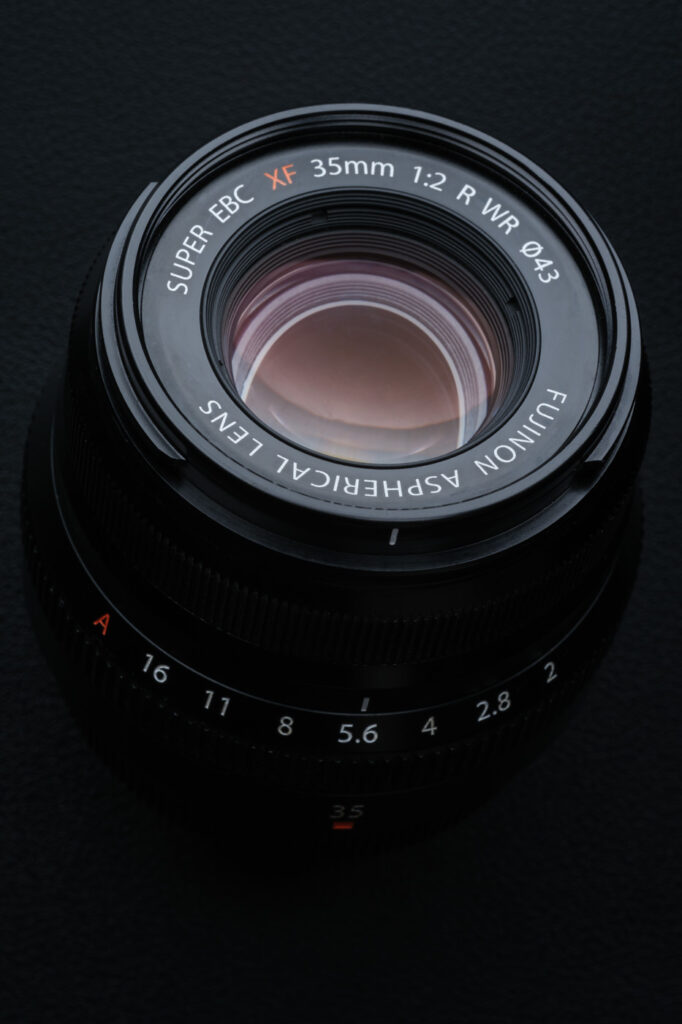

Build Quality
Weight and dimension
One of the many things I like about this lens, is its size and weight. Weighing at only 170g/6oz, with a dimension of 60mmx45.9mm. Making it a very compact, and practical for all day shooting without fatigue.
In fact this lens is paired with my XF 23mm F2 most the time, whenever I’m out shooting travel or street photography, because of how portable they are.
Aperture ring
Like all other Fujinon lenses, the XF 35mm f/2 has a similar standard in build quality that Fujifilm abides by. It has an all metal exterior construction that feels premium when handling it, with a manual aperture ring that clicks into place with confidence, and has a 1/3 stop adjustment per step.
This is the newer superior design in aperture ring, that’s seen on the XF 23mm and XF 50mm as well, you won’t accidentally bump it and change the aperture, like I do a lot on the XF 56mm MK I, which practically has zero tension to keep itself in place and can get quite frustrating.
Focus ring
The focus ring has a decent throw to it, and like most other Fujifilm X lenses, it uses the focus by wire technology. Some people hate it as it’s not as consistent and precise, which is something I never found to be the case on the precision part.
Focus by wire means that the focus ring doesn’t have a “hard stop” at the closest focusing distance to infinity and will just keep on rotating.
However, personally I do like the mechanical focus technology better when it comes to user experience aspect, it is consistent in the sense where you know exactly what the focus is set to and the camera won’t override the focus point from half pressing the shutter down if that’s the style you shoot in.
The width of the focus ring is quite thin, but this is to be expected for a lens of this size.
Weather resistant
The Fujifilm XF 35mm f2 is weather resistant making it safe to shoot in harsh environments. Which I can attest to, in my own shoots where I’ve shot in rainy, stormy, very humid, and even sandy/dusty condition without any issues.
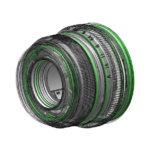 As an example, I was in Bali recently and taking my kit out from the room which was very chilled from the A/C, to the outside where it was around 90f and 90%+ humidity, the outside of the lens quickly built up a lot of condensation, but none of it accumulated inside of the lens and I was able to use it straight away by giving it a quick wipe after the temperature of the lens matched the environment.3
As an example, I was in Bali recently and taking my kit out from the room which was very chilled from the A/C, to the outside where it was around 90f and 90%+ humidity, the outside of the lens quickly built up a lot of condensation, but none of it accumulated inside of the lens and I was able to use it straight away by giving it a quick wipe after the temperature of the lens matched the environment.3
Lens Hood
Unfortunately, the lens hood for the XF 35mm f2 falls into the worst category for me here.
Not only is the length of the hood being too short that if you’re shooting during near sunrise/sunset and not being able to block it out, but it also uses the filter thread to have it attached, meaning you won’t be able to use any filters if you decide to have the lens hood on.
The application to have it on/off and the actual practicality are both poor, and I firmly believe it needs a better design.
It’s no secret that many people are not fans of Fujifilm’s lens hoods, which I never really thought to be the case until I used this lens.
On top of that, I recently got to play around with one of my best friends’ Sony system when I went back to Australia to visit family and friends. And I have to say I was blown away by the attention to detail that Sony puts in, even just into their lens hood!
They have what you would expect such as an adequate length to block out light source when needed. But the impressive part is that the end of the hood is rubberised, so when you put the lens down on a surface, it’ll grip onto it and not move around but also serves as a protection to the edge of the hood.
Last but not least, and this is a big one. They have a lock on the lens hood that will lock onto the lens! Given that all the Sony lenses I played around with were G Masters, so I’m not sure if they have it to their other lower quality lenses. I think Fujifilm could learn and follow the steps of Sony, or any other manufacturers that has the same concept.
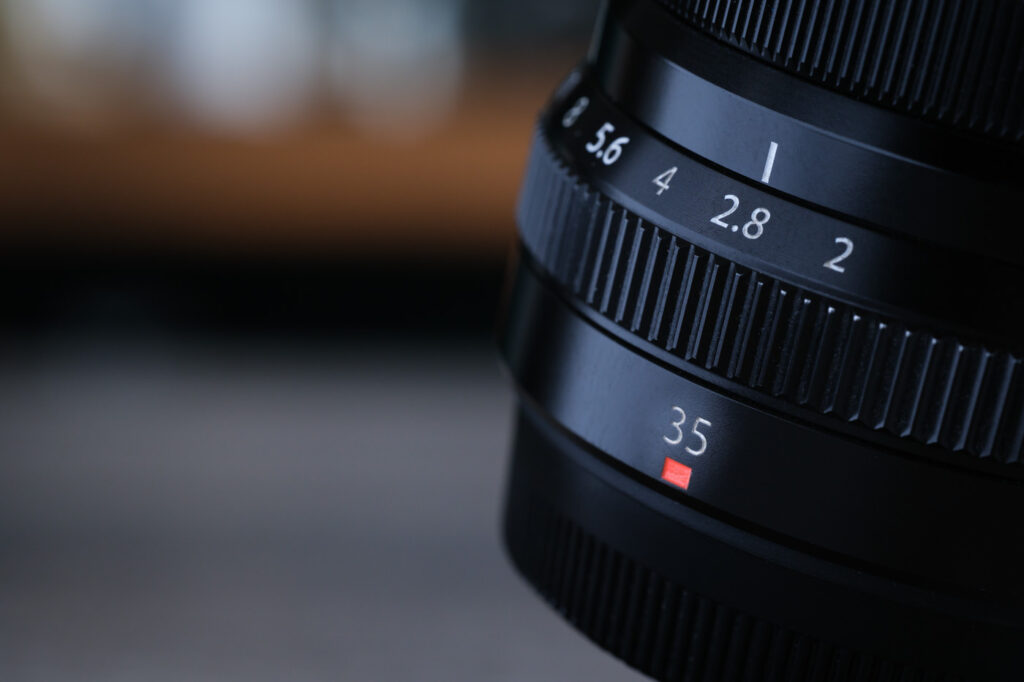
Image Quality
Sharpness
From my experience, the XF 35mm f2 has exceptional sharpness in the centre, I’m talking about impressive level of sharpness, where it gives the more expensive counterparts a run for its money. The corners has noticeable softness to it, but since I primarily shoot portrait, it is more than adequate for my use.
Stopping the lens down to f2.8, and you immediately ripe the benefit of both centre and corner sharpness being enhanced. By f4-f5.6 and you’re hitting maximum lens sharpness, before a slow degradation due to diffraction, but I will say, unless I’m pixel peeping, which I don’t often do at all, so it won’t be an issue in most application, unless corner sharpness is important to you at the fastest aperture.
Bokeh
For a lens that has an aperture of F/2, you obviously won’t be seeing shallower depth of field like the faster lenses. Having said that, the Fujifilm XF 35mm F/2’s bokeh is charismatic and it produces very pleasing quality softness.
There’s really not much more to say about the bokeh other than that it does yield cat eyes on the edges of the frame, which is something to be expected, not just on this lens but on most lenses. There are no onion ring in the bokeh balls, and do note that the 9 aperture blades are only fully rounded when it’s wide open so it’ll cause different results in bokeh shape, depending on what aperture you have set.
One thing I’ll note, I don’t shoot pictures for bokeh balls. I don’t deliberately look or care for backgrounds with them, and have no interest in it. That’s never the focus when I look at an image. The main subject and the emotions that an image produces will always comes first and foremost for me.
Sunstar
Performance
Auto Focus
The autofocus on the XF 35mm F/2 is lightning fast. It’s confident in locking focus with precise accuracy on a subject. This is in large due to its size in optics construction, moving the minuscule of glass within the lens, all whilst using a stepping motor which is more than enough power to drive such lens.
The autofocus works flawlessly whether in single servo or continuous focus mode. The motor sound is near undetectable when filming in video mode, and I’d say it is perfectly fine to use this lens for video even in near silent environment.
It is one of the lenses where I can fully trust in it to do its job every time. This level of confidence is not given lightly as some of Fujifilm’s older lenses are just not up to par when it comes to the AF department.
The autofocus performs fairly well even in low light, it mostly locks on just fine, although sometimes it does hunt a bit in at times, but I’ve experienced this even with some of their more premium and faster lenses.
With the XF 35mm f2 being such a tiny nugget, it is no surprise that the autofocus on this lens is lightning fast, considering it’s more of a “mid tier” lens.
Focus Breathing
This lens does have some focus breathing, but from my testing, it’s noticeable but I wouldn’t say it is major. The best way to demonstrate is to show it here down below.
Size and Weight
The XF 35mm F2 is less than half the weight, so I have zero fatigue shooting with it all day long, whereas I definitely notice a light fatigue from shooting with the XF 33mm F1.4 after a while!
For example as I was packing last night for a week trip to San Francisco and San Diego, California, where I’ll be exploring and sightseeing. I stood there looking at my collection of gears thinking to myself which lenses I wanted to bring with me.
Since I’m restricted with what can fit in my Peak Design 3L Everyday Sling which goes in the day pack along with my other belongings.
I usually always opt for the smaller and lighter lenses for solo travels, but if there’s companions with me, then perhaps a balance of having a fast prime also for some portrait opportunities.
In this case, I had the XF 33mm F1.4, XF 90mm F2, and you’ve guessed it, the XF 35mm F2!
And since I plan on taking my camera with me everywhere as I trot around my day, everyday of the trip. I wanted this lens to be my primary lens of choice, it’s a good focal length for street and portrait. Just as importantly, because it won’t feel like the gear is dragging me down with its weight/size, taking away the experience of my day whilst roaming around.
Another advantage with the XF 35mm f2, as mentioned above, is its size. Being inconspicuous and staying hidden like a fly on a wall, which is very important if you want to stay stealth for street photography.
People will look at you and think “Oh cool, this guy’s got a nice camera.” (Think tiny and not big-like pro) and be perceived to be less threatening, as opposed to the XF 33mm f1.4 where some may be a little bit more alert as it stands out more.
It doesn’t sound like much, but trust me when you compare the two, it’s a huge difference. You can see that below yourself.
*insert lens size diff*
Real World Usage
I’ve done many shoots with this lens in all types of condition, and it’s a lens I very much enjoy shooting with, due to how well the over performance and handling is. Because this is such tiny lens, I tend to either grab this lens and/or the XF 23mm F2 as my go to if I were only to bring one lens out with me while I’m shooting travel or street photography.
Don’t underestimate the power of such lens being so lightweight and versatile. The difference in holding and carrying this lens compare to say, its newest bigger brother, XF 33mm f1.4, which is quite noticeable especially over an extended time.
Whether it comes to portrait or street photography, the two types of photography where I shoot the most, and it does an amazing job.
In fact this was the only 50mm FF equivalent lens that I owned for the longest time until I acquired the XF 33mm f1.4 when it finally came out, which is what I shoot portraits with now, if I was to choose to shoot with this focal length.
In my experience, this lens is more than capable in doing a pro portraiture shoot and I wouldn’t hesitate to use this as my lens of choice if I didn’t want to use a heavier lens.
The image quality is sharp and pleasing. It is very easy to use, focuses locks on as expected.
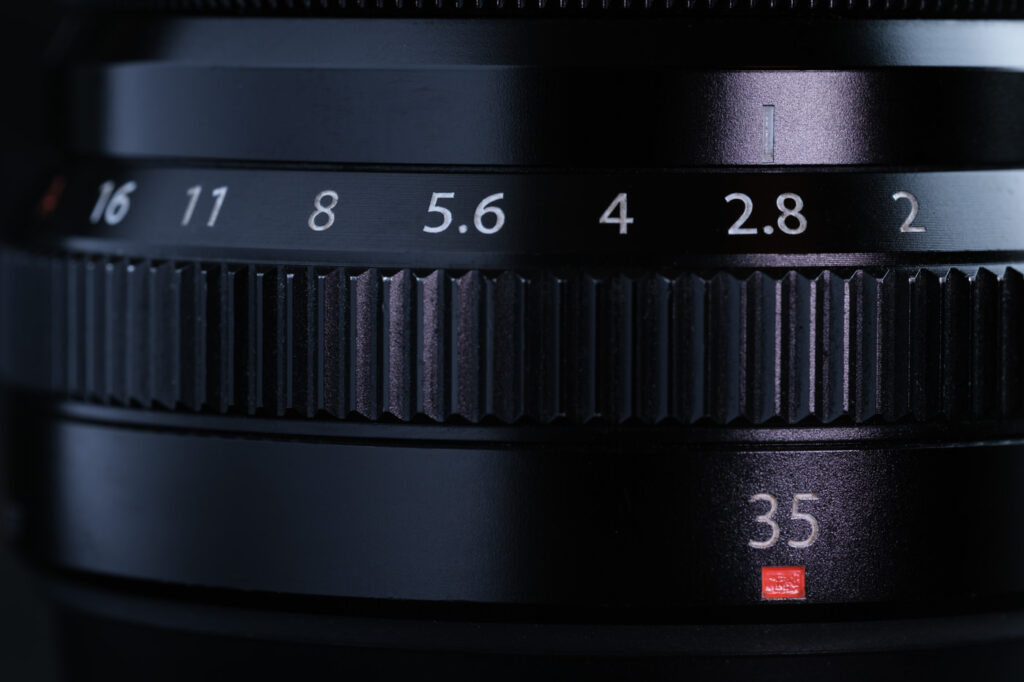
35mm Comparisons
As I’ve mentioned in the intro, there are an abundance of 35mm(ish) full frame equivalent lenses out there, no matter which systems it’s for, and it is no exception for the Fujifilm APS-C system either. Below are lenses that are currently available for Fujifilm, where you can see some pros and cons of each in comparison to help you make a wiser decision in obtaining the lens that’s suited for you in this focal length.
Fujifilm XC 35mm F2
If you are budget conscious but want the same performance, then I have good news for you. This is the exact same lens as the XF 35mm F2, optically, except the construction is made of cheaper material, namely plastic. It does not have an aperture ring, so you’ll need to be changing that through whatever option you’ve set to adjust that in the body. It is also not weather sealed so I wouldn’t use this lens if you were to shoot in extreme conditions.
However, if that’s not a concern for you and you don’t mind the less premium feel and construction of the lens, then I would highly recommend this as it will perform exactly the same as the XF version, that’s 30 grams lighter, and you get to save half the cost.
- PROS
- Cheap, half the price of the XF version
- Same optic quality as the XF version
- CONS
- Plastic construction
- No weather sealing
- No aperture ring
Fujifilm XF 35mm F1.4 R
The XF 35mm f1.4 is a well known classic in the Fujifilm X system with a 53mm field of view in FF equivalent. It is one of the oldest lenses that the X system offers. It is often praised with the image quality of “magic”.
I don’t like when terms like this are being used on a lens as you can’t actually quantify or measure what that really means. It is said by Fujifilm that this lens was deliberately created to not be “optically perfect”. Meaning that on they didn’t create this lens to be impressive on their MTF chart, having the intention to design the lens that is flawed to render the image that will give it that “magic”.
Being one of the oldest lenses in the X lineup, the tech in it goes to show its age also. Let’s start by the Autofocusing system, which is where I see it being the biggest flaw of them all of this lens. It uses an external focusing system, meaning that the front of the lens will physically zoom in and out.
To add to that, the speed is sluggish when compared to its little brother XF 35mm F2 or any other modern lenses out there. Last but not least, the motor is very audible when it is hunting for focus, so this lens is a no go for any video work due to this, plus the speed or there lack of, in acquiring focus in a speedy manner. Finally, it is not weather sealed, so you wouldn’t use this in extreme conditions.
That’s a lot of cons! But to counter that, this lens also has a lot of pros. It is a fast lens with an aperture of f/1.4, so you will get really nice bokeh with it, topped of with the flawed design to give it that “magic”, images may appear to be dreamy and “3D” as some claims.
To add to to that, it is pretty lightweight for such a fast lens weighing in at 187g/6.6oz. I’m a fan of size and weight for a lens in this category. And to wrap up the pro, you can find this lens brand new anywhere between $550 to about $600 USD, or you can find a used one easily for about sub $200-$300 on eBay.
So who’s this lens for? If you’re looking for something creamy, dreamy, with a touch of “magic” and a pop of “3D”ness, that’ll do well in lowlight (aperture wise not AF speed) and you don’t shoot fast subjects or require video work with it and you’re not bringing this to the Sahara desert, then I’d say this lens would be a pretty good choice for that market, especially if you get a second hand one which is what I would recommend.
Oh, and this lens won’t be able to fully utilise the new 5th gen X-Trans sensor either, that’s not to say the images won’t be good, it just doesn’t have the resolving power like the others do.
- PROS
- f/1.4 aperture
- Good weight and size
- Legend says it creates “magic”
- CONS
- External focusing
- No weather sealing
- Slow and noisy focus
Fujifilm XF 33mm F1.4 R LM WR
https://fujifilm-x.com/en-us/products/lenses/xf33mmf14-r-lm-wr/
In preparation of the 5th generation X-trans processor, Fujifilm started refreshing a range of their lenses that will support the new 40.2 megapixel sensor. And this is the answer they came up with. It is a refined and clinical lens with superb sharpness, this is shown in the MTF chart and it is exceptional, leaving it little room for errors.
Weighing in at 360g/12.7oz it is a lens that’s twice as heavy and considerably larger in size, it also carries a price tag that’s twice as much.
So what do you get in return for paying double the price? Ultra high image quality, state of the art autofocus speed with its linear focusing motor, and weather resistance. It is the best lens you can get with money for the Fujifilm X system in this focal length. I personal own this lens and am attesting to this. This is exactly what you’d expect from a modern lens that came out in 2021.
If you want the best of the best 50mm in terms of quality, and you don’t care about the other factors, then adding this lens to your kit is a no brainer.
- PROS
- Best image quality
- Ultra fast autofocus
- f/1.4 aperture
- Weather sealing
- CONS
- The most expensive lens of the bunch
- Larger size and heavier weight
Fujifilm XF 30mm F2.8 R LM WR Macro
https://fujifilm-x.com/global/products/lenses/xf30mmf28-r-lm-wr-macro/
As of writing of this review, the XF 30mm f2.8 Macro is the latest addition to the 45mm equivalent focal length.
- PROS
- Very sharp
- Great size and weight
- Ultra fast autofocus
- Doubles as a macro lens
- CONS
- Slow aperture at f/2.8
Viltrox 33mm F1.4
Overall, the Viltrox 33mm f1.4 is a great lenses offering good image quality and performance. There’s a caveat though, this lens is really sharp in the centre, but for the corners, it is on the other end of the spectrum of being really poor.
This however, gets slightly improved at around f2.8 to f5.6. It has a stepping motor for the autofocus system, which seems to be pretty fast in locking focus.
The build quality is good, it is mostly made out of metal, including the lens hood. The only part that’s made of plastic on the exterior is the aperture ring, which by the way, is step-less with no tactile.
As a photographer, I’m not a big fan of this at all, but could be good for the videographers out there. Sadly, this lens does not have weather sealing, nor does it have lens correct profile embedded. So this is something to take note of.
It weights at 270g which is pretty middle ground and it’s a good compromise with what you get. And at a price of $279 USD, I think this is a great option for those looking to an alternative from the Fujifilm 35mm F2.
- PROS
- F1.4 aperture
- Great centre image quality
- Good price and weight
- CONS
- Poor corner image quality
- No embedded lens correction profile
- Non-click/tactile aperture ring
- No weather sealing

Conclusion
Scoring Chart –
Build Quality
Image Quality
Performance
Value
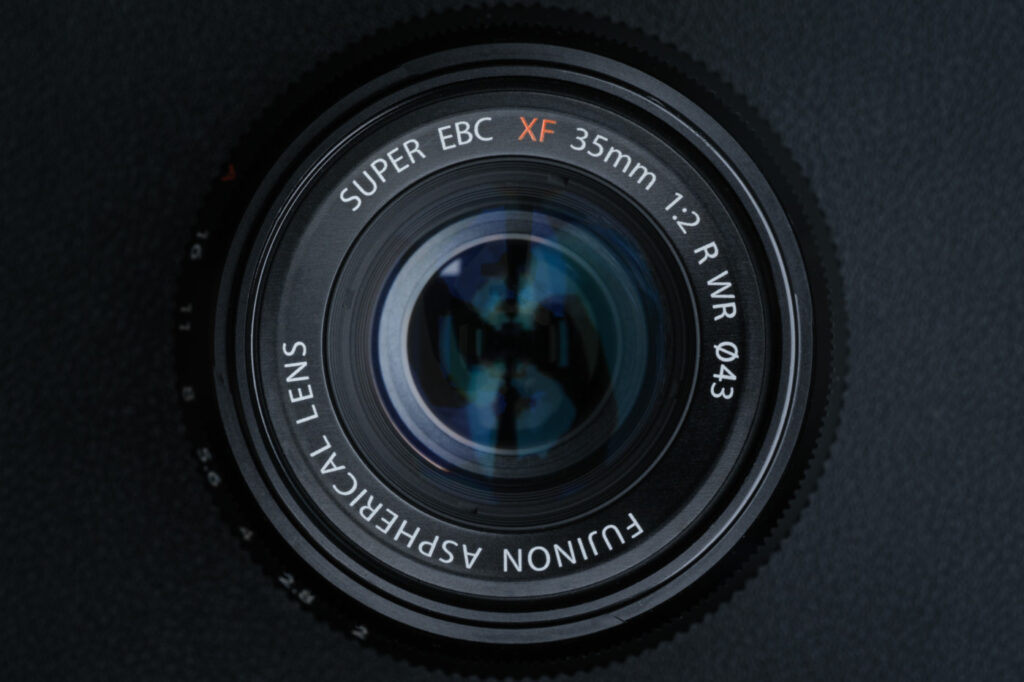
Sample Images





















































































































































